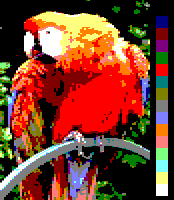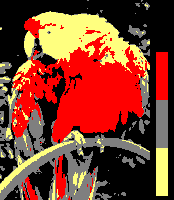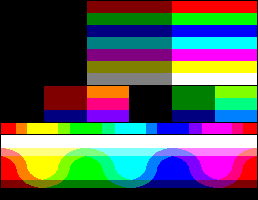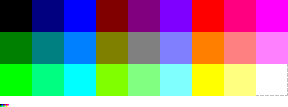Contains stuff from Wikipedia.
The standard video modes or Screen Modes.
As a Colour Personnal Computer, perhaps the Amstrad CPC best argument (beside being cheap, fully equipped and well rounded) was his video capability. Yet this was also heavier for the Z80 to handle compared to other lighter diplayers such as ZX Spectrum.
Also Amstrad's Video RAM was shared on the Z80 RAM. This and a cheap conception with the fewer specific chip to ease the CPU could turn it into a sluggish snails if badly programmed.
Yet colourfull games with few scrollings requirement, reflexion games such as KLAX... were perhaps the easiest medium for a CPC to shine above other 8 bit computers.
Too bad too few graphicaly-heavy RolePlayingGames were produced.
Specifications
Those are :
- Mode 0: 160×200 pixels with 16 colors (4 bpp)
- Mode 1: 320×200 pixels with 4 colors (2 bpp)
- Mode 2: 640×200 pixels with 2 colors (1 bpp)
- Mode 3: 160x200 pixels with 4 colors (2bpp) (this is not an official mode, but rather a side-effect of the hardware)
The Video modes are known to display pixels with different sizes.
Basically, the Amstrad CPC Video work like a CGA video card from a PC. But extra features like a 16 colours mode exist.
The dimensions in pixels given could be raised with clever use of FullScreen Mode.
This then allows with a video memory of 24Ko (approximately) to displays on the standard screen up to :
- Full screen Mode 0: 192x272 pixels with 16 colors (4 bpp)
- Full screenMode 1: 384x272 pixels with 4 colors (2 bpp)
- Full screenMode 2: 768x272 pixels with 2 colors (1 bpp)
Also the use of canline may increase vertical resolution.
Colours attributes
The Amstrad CPC is perhaps the only cheap personnal computer of his generation with absolutly no such thing as character's colour attributes.
Speccy was awfull for this, and even better computers had modes with it.
Later Thomson 8 bit computers (MO6 and TO8) used to have the same Video Modes and Palette as the Amstrad Plus and an additional Mode (320x200 and 16 colors with attribute limitation from 4096 colours palette)
C64 and MSX also had Colours attributes, yet also some modes without or with less limitations than Speccy, and later models (C128, MSX2+ and 3) were also designed with even better extra non attributed modes.
As a result, an Amstrad never see any faulty colour clashes... despite the numerous speccy ports, because it cannot unless voluntarily programmed.... This saved many speccy ports indeed.
Is this better ? Well colours attribute system allow a good resolution with more than 4 colours displayed on screen with few efforts.
So this would be interesting to display...colourfull texts.
Yet fine graphics with a really colourfull feeling become harder to get, so are nice metallic or graphical effect letter fonts with 4 colors...
Colours
- 3-level RGB
The Amstrad CPC (old) palette features 27 colours, despite the fact that the Video system (Gate Array and CRTC) could actually handle 32 colours.
Because this is a 3-level RGB custom palette.
This palette is used by the Amstrad CPC old series only and is not found in any other computers (but clones of course).
The 3-level (not bits) RGB uses three level for every red, green and blue color components, resulting in a 33 = 27 colours palette.
A notabble specificity of the Amstrad CPC palette is that it offers only one "Grey".
Compared to the C64 with...er...only greys..? (Humor inside)
This explains why in some games rocks and stone are coloured in other shades to get a good colour layer with more than 3 shades (black, grey and white).
- Exemples : Defender of the Crown with Purple rocks and stone walls... Also Barbarian.
It is also notable that this palette has a "lot" of Blue and Green variations... It is possible to use a mode 0 screen with almost only 16 pseudo Green and Blue colours (yet a bit purple for some of them).
Many graphists used mostly coloured flashy bold colours as it was often reproached by other 8bit fans (C64...).
But a clever choice in said colours could also give good results too in Pastel shades.
Yet Amstrad CPC had clearly a better palette (in number) than Speccy, C64, or almost all post-1985 8 bit computers.
It was a bit of a shame that some of its colours were almost identical...
- 12-bit RGB
Used by the Amstrad Plus series.
It's like the good old Amiga 500 palette.
Systems with a 12-bit RGB palette use 4 bits (16 values) for each of the red, green, and blue color components. This results in a 163 = 4096 colours palette. From the 8 bit era, only the latter MSX specs had a greater palette (in number).
Mode 0 graphics
Mode 0 graphics are blockier thanks to the "2x1" ratio.
 Courtesy from Wikipedia.
Courtesy from Wikipedia.
Yet the good amount of colours allows to use AntiAliasing technics to soften the shapes.
It is the mode that made CPC a Colour Personnal computer.
Ditherings are sometimes used in this mode, yet the good number of colours allows better colour layers.
Dithering more offers a good "texture" or feel effect than real "new colours".
Mode 1 graphics
The pixels are square, but the only 4 colours a bit... few.
 Courtesy from Wikipedia.
Courtesy from Wikipedia.
Yet a massive amount of horizontal "split rasters" allows to multiply the number of colours displayed on the screen.
It's like using the colour attribute specificity (as on ZX Spectrum) but with horizontal limitations.
Basically a CGA standard PC video display.
Pictures and graphic material have to make good use of ditherings in order to get a realistic look, yet the square pixels allow smooth ditherings.
Mode 2 graphics
The pixels are 1x2, extremly slim.
 Courtesy from Wikipedia.
Courtesy from Wikipedia.
This mode is difficult to use in a coloured way.
Better used as a Text Mode, yet it can be included in a splitted screen (games).
Because of this Mode, the Amstrad CPC was perhaps one of the 8 bit computer able to display the highest screen resolution in Full Screen (the so called "overscan")...
You have to dither a lot to get a good picture as there are no real colours shades.
Border
The border allows 1 another additionnal colour to be displayed on the screen with no tricks.
Amstrad Plus
The Amstrad Plus display the same modes, but 15 more colours can naturally be displayed thanks to the Hardwired Sprites.
This means 32 colours per screen with no tricks (including Border).
Also it is worth noting that the resolution of those Sprites (16x16 pixels) can be displayed through "magnification".
The basic x1/x1 pixel is like a Mode2 Pixel (a x=1 and y=2 ratio...or X= 0.5 and Y=1).
This can be multiplied by x2 or x4 in both dimensions (X and Y).
A mode 1 like pixel must then be a x2/x1 pixel. A mode 0 like pixel x4/x1.
Related pages
External Links
Wikipedia's pageon the different 8 Bit systems Hardware Palettes and Modes including amstrad CPC of course...
Wikipedia's page on RGB palette including Amstrad CPC specific one
Les Sucres en Morceaux the French site from supersly, shows many exemples and technics to use the different Video mode of the amstrad CPC.



